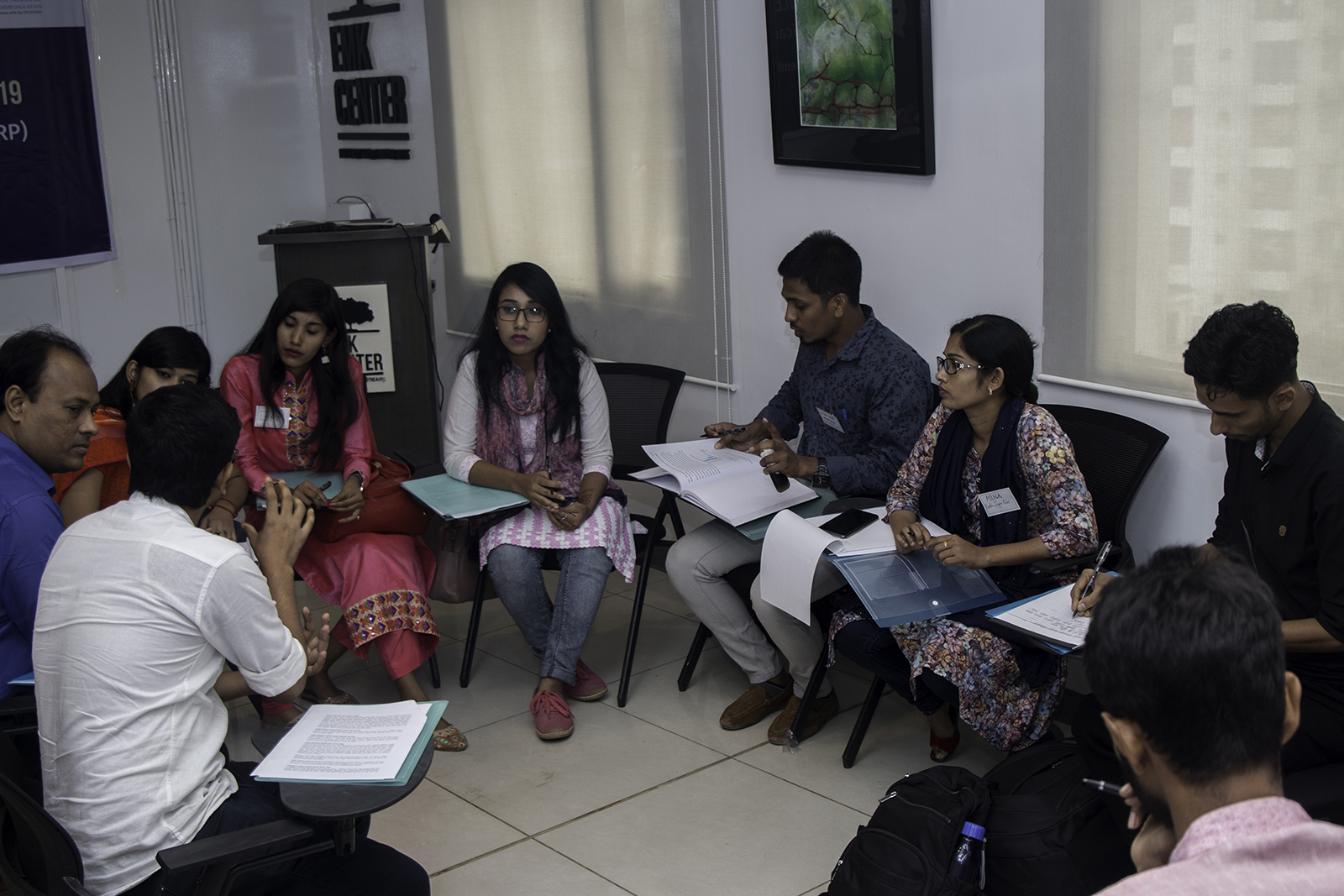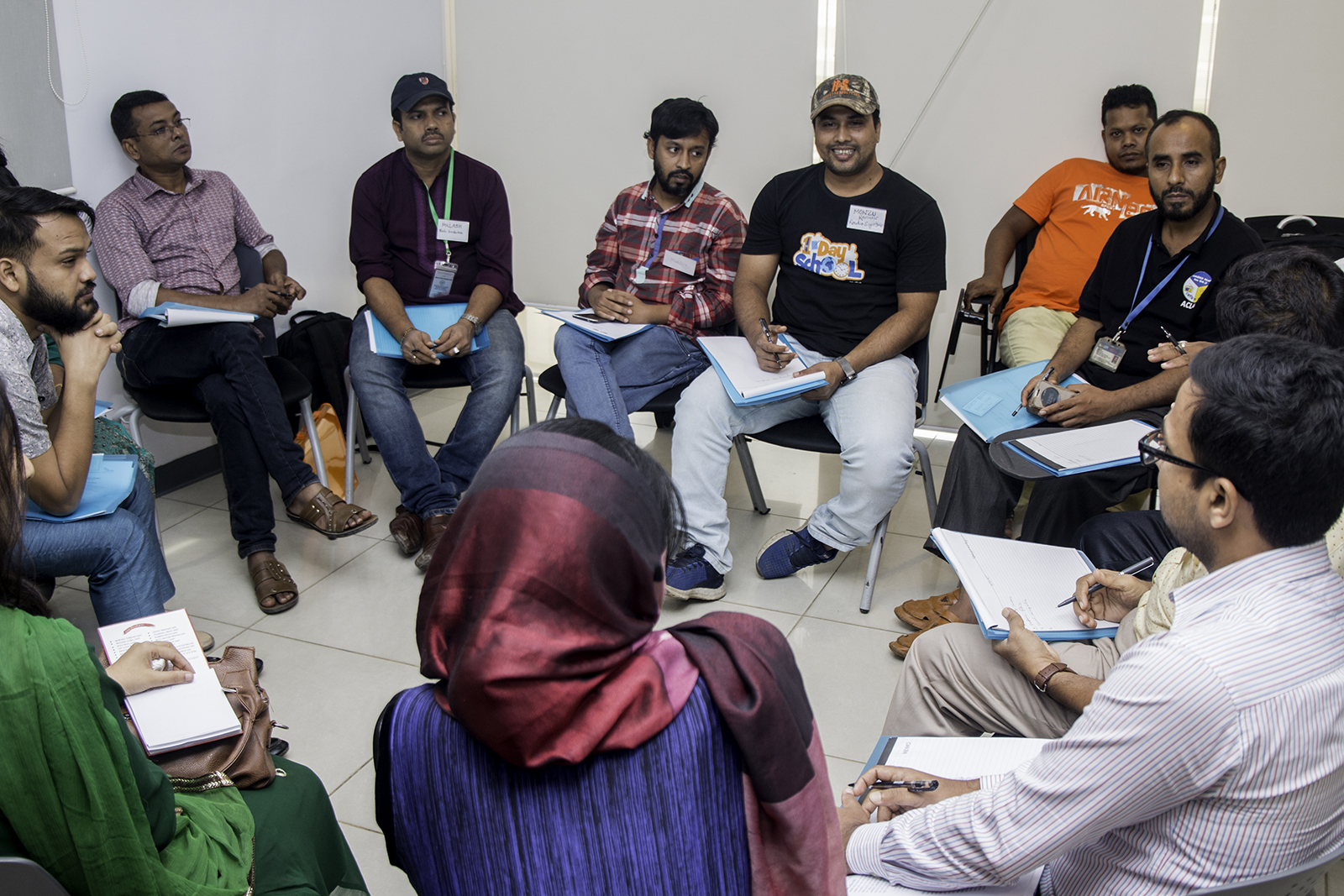Executive Summary
Gender-responsive communication is a must-have skill for all development practitioners. Whether writing reports or emails, speaking to a crowd or interacting with people at the grassroots level, all must be aware of the ways in which language can either enforce or subvert gender inequalities.
Bangladesh NGOs Network for Radio & Communication (BNNRC), has implemented Gender Responsive Communication for Community Radio (CR) broadcasters with support from Free Press Unlimited, aimed to build capacity of the broadcasters to develop gender-sensitive and gender-responsive contents for their Hyperlocal rural audiences for increasing awareness to response, pursue, protect and prevent in all sorts of gender-based violence.
BNNRC, since its inspection, has organized a series of orientations and workshops for Community Radio (CR) broadcasters on gender-responsive communication”. More than 500 CR broadcasters including BNNRC staffs participated in the training-workshop at the national and regional levels. Presently, the trained CR Broadcasters (50% female broadcasters) have been broadcasting 138 hours radio programs daily on development contents like- information, education, local entertainment, and development motivation activities covering 6.8 million rural audiences of 121 Upazilas (sub-districts) under 16 districts in Bangladesh.
Activity’s description:
BNNRC believes that gender equality is a core concern of the organizational decree, not being considered as a cross-cutting issue. In this connection, Community Radios constitute a diverse and professional landscape and function as change agents of the people living in rural and remote areas. BNNRC is always giving the highest priority to mainstreaming gender in all CR stations in Bangladesh.
All 18 CR stations have been following gender-responsive communication during developing their content. For their outstanding efforts in empowering the community, providing access in media as a platform to raise voice (especially for girls and women) as well as influencing power groups to response, pursue, protect and prevent in reducing gender-based discrimination and injustice in societies.
BNNRC strategically introduced a gender equality policy for all CR Stations. The policy not only being followed by the management of all CR Stations (CRSs) but also by the CR broadcasters during program productions and awareness-building activities among their rural audiences. This policy also distributed among the concerned policymakers for strengthening lobby and advocacy in creating a gender-friendly environment of all CR Stations.
“Gender Responsive Communication for Community Radio Broadcasters” orientations and workshops for the Community Radio broadcasters helped the Broadcasters in producing and broadcasting gender-responsive content.
“We are very confident about to receive an award in any national or international contests. The capacity supports we received from BNNRC was the secret behind this achievement”, said Sumi Akhter, a Broadcaster, CR Bikrampur.
Considering the power of social media, the youth community broadcasters are also promoting gender-responsive development agendas among their wider communities. The initiative also helped the CR broadcasters, especially women broadcasters to handle all technological barriers and disseminate their program contents through social media in the era of the 4th Industrial Revolution.
Background Information:
Economic and political empowerment of women and gender equality have been considered as a core component as well as a cross-cutting issue in achieving all Sustainable Development Goals (SDGs) since the matter has been less focused or almost absent in mainstreaming community media coverage before BNNRC’s intervention in gender-responsive communication.
Besides, one of the most important backdrops in this media was the lack of professional skills and proper understanding to cover different development issues in media. keeping this in mind, BNNRC introduced gender-sensitive content development and gender-responsive communication in all Community Radio Stations (CRSs) to build capacity and improved understanding of the broadcasters and managements.
It was very crucial, particularly in rural and remote areas where the majority of the population has no proper education and access to information and media of their own.
Considering its importance, since the beginning of all CR stations, BNNRC has been implementing gender-responsive communication following the produced gender equality policy, which was accomplished as a core organization’s policy, has been implemented in all segments, i.e. covering research, policies, programs, and projects.

Project Objectives
The goals and objectives of this action were as follows:
- Mainstreaming gender in BNNRC as well as all CR Stations to integrate the concept of gender equality.
- Ensure to follow gender-responsive communication guideline during designing all knowledge and information materials, program scripts, etc.
- Evolve gender-sensitive mindset of the local communities living in CR Station coverage areas in creating an inclusive and peaceful environment through listening to all gender-responsive messages and programs.
Major interventions under this action of BNNRC
The gender equality policy is being followed by all management and broadcasters of all CR Stations (CRSs) as a mandatory basis. BNNRC instructed the CR broadcasters to produce and broadcast programs by following the “Gender Equality Policy”. Their media contents, refer to fair gender portrayal in news and programs including all capacity building supports in the following manners:
- Keep gender balance in decision making
- Fair and balanced representation of men and women in every program;
- Elimination of stereotypes and promotion of multi-dimensional representation/portrayal;
- Increased coverage of gender equality issues, including gender-based violence.
- Institutional commitment to promoting gender-sensitive practices in an organization’s ethical codes / editorial policies;
- Gender balance in training: equal access and participation of men and women trainees;
Examples of Linkages between the WSIS Action Line and the SDGs
The project has addressed the Action Line C4 (Capacity building). Until the introduction of the gender-responsive communication concept in all capacity-driven programs and training, the majority of the broadcasters did not have proper sensitization on this issue. The initiatives of this action are facilitating directly in SDG 05, 10 and 16.
In SDG 05: All efforts of the aforesaid initiative, contribute in the 2030 agenda significantly increase investments to close the gender gap, to strengthen support for gender equality at all levels in community media sectors, systematically embed gender perspectives into all communication package to build accountability and give primacy to women’s leadership at all levels.
SDG 10: Equal visibility in gender-responsive communication means, for women and men, is not enough. This applied communication contributing to the radio stations ensuring fair visibility blocked gender stereotypes and allows men and women to be on equal footing. The visibility was also achieved by presenting a diversity of roles for both women and men, engaging multi-stakeholders, especially for the low cast communities (Dalit) including persons with disabilities, transgender, etc.
SDG 16: Contribute to promoting peaceful and inclusive gender-friendly societies. Sensitize communities in access to justice and build effective, accountable and inclusive institutions at multi-stakeholder groups. Providing access to information and knowledge to people is also important to fostering tolerance between people and contributes to more peaceful societies by bridging the existing gaps between men and women, power groups and right-holders.

Case of a Participant
Parvin Nahar, a woman, the Station Manager of Community Radio Jhenuk recalled her better and bitter experiences at the beginning of her career at Jhenuk. She was the first and one of the successful Station Manager in Bangladesh. She added that our society is man-dominated, and it was quite difficult for a woman to manage a team like radio Jhenuk where the majority of the staff are youth male. Struggling a decade, the situation gradually improved and she succeeded to build a team, where 50% broadcasters were youth women. She also appointed a woman as the Asst. Station Manager at CR Station Jhenuk. Presently, one-third of the radio station managers out of 18 are female and promoting gender-responsive communication and advocacy.
Conclusion:
Gender mainstreaming in community media is being a core mandate of BNNRC to achieve Sustainable Development Goals (SDGs). In spite of the social and religious barriers such scenario in gender disparity, particularly in media, has been gradually changing.
Since 2000, BNNRC, under the banner of ‘voices of the rural people,’ has been at the forefront in breaking the traditional biased focus towards urban areas. BNNRC has been playing a leading role in bringing the media’s focus on rural areas. Community Radio, being the only broadcasting media in rural Bangladesh not only broke the traditions but also spearheaded in creating a platform for women from the grassroots level to raise their voices to be heard through promoting gender-responsive communication channels.
The capacity-building initiatives adopted by BNNRC have resulted in a flood of women filling the posts of producers, anchors, newscasters, reporters and station managers in 18 community radio stations around the country.
Secondly, developing gender action plans contained clear objectives and targets linked to the action’s mandate and tracked through an effective monitoring and reporting system, and were adequately resourced.
Build an inclusive and peaceful society, which refers to advocate for gender equality and work towards increasing participation in programs and leading position of women in and through the community radios in Bangladesh. These kinds of sensitization have sustained at their knowledge as well as behavioral level, which will inherit generation to generation thus will enlighten the communities.
Views on WSIS Stocktaking and Prizes contest:
WSIS Stocktaking and Prize will be an inspiring model for the community media practitioners in different parts of the world. The winning of the prize will be inspiring to our future broadcasters and policy-makers.
About: BNNRC
Bangladesh NGOs Network for Radio and Communication represents the community media sector to Government, Industry, Regulatory Bodies, Media and Development Partners.
BNNRC has been struggling for the last 20 years to open up the community media (including Community Radio, Community Television) and giving focus on its vital role as voices of the voiceless rural people. The reality of today is that the bondage between the community people and local-level community radio stations are getting strengthened day-by-day. Community Radio has now become part of life and livelihood.


